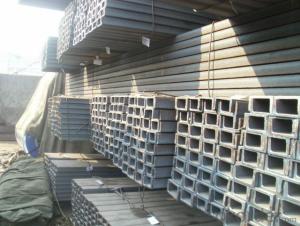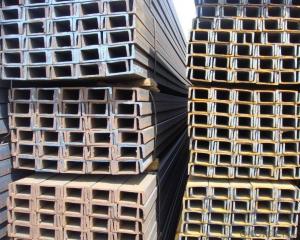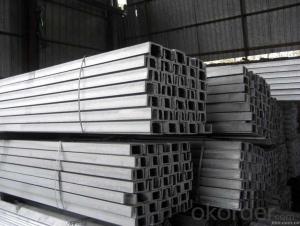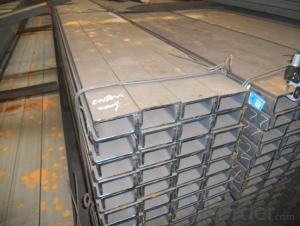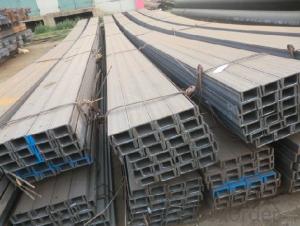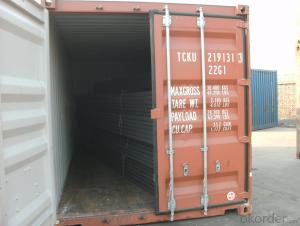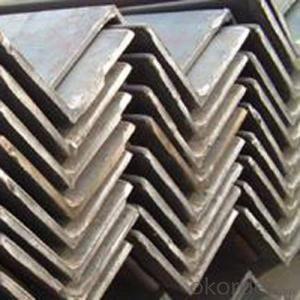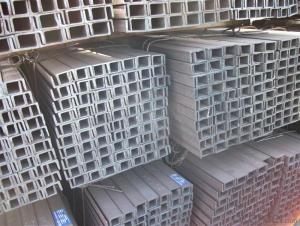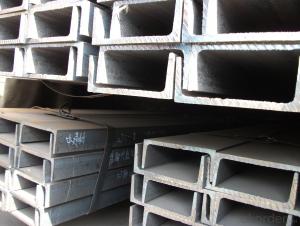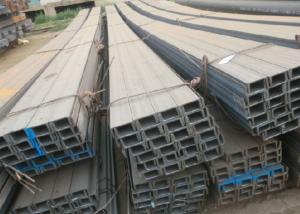U Channel Hot Rolled Steel Made In China GB JIS EN DIN
- Loading Port:
- Tianjin
- Payment Terms:
- TT OR LC
- Min Order Qty:
- 50 m.t.
- Supply Capability:
- 40000 m.t./month
OKorder Service Pledge
OKorder Financial Service
You Might Also Like
Specification
Product Description:
OKorder is offering U Channel Hot Rolled Steel Made In China GB JIS EN DIN at great prices with worldwide shipping. Our supplier is a world-class manufacturer of steel, with our products utilized the world over. OKorder annually supplies products to European, North American and Asian markets. We provide quotations within 24 hours of receiving an inquiry and guarantee competitive prices.
Product Applications:
U Channel Hot Rolled Steel Made In China GB JIS EN DIN are ideal for structural applications and are widely used in the construction of buildings and bridges, and the manufacturing, petrochemical, and transportation industries.
Product Advantages:
OKorder's U Channel Hot Rolled Steel Made In China GB JIS EN DIN are durable, strong, and resist corrosion.
Main Product Features:
· Premium quality
· Prompt delivery & seaworthy packing (30 days after receiving deposit)
· Corrosion resistance
· Can be recycled and reused
· Mill test certification
· Professional Service
· Competitive pricing
Product Specifications:
Standard Applied: GB Standard, EN Standard(UPN), JIS Standard
Sizes: 50mm to 300mm
Material Grade: Q235B, Q345B, S235JR, SS400, ASTM A36
As shown in the figure:
JIS U CHANNEL | Standard h | Sectional b | Dimension s | t | Mass: Kg/m |
(mm) | (mm) | (mm) | (mm) | ||
50x25 | 50 | 25 | 3.0 | 6.00 | 2.37 |
75X40 | 75 | 40 | 3.8 | 7.00 | 5.30 |
75X40 | 75 | 40 | 4.0 | 7.00 | 5.60 |
75X40 | 75 | 40 | 4.5 | 7.00 | 5.85 |
75X40 | 75 | 40 | 5.0 | 7.00 | 6.92 |
100X50 | 100 | 50 | 3.8 | 6.00 | 7.30 |
100X50 | 100 | 50 | 4.2 | 6.00 | 8.03 |
100X50 | 100 | 50 | 4.5 | 7.50 | 8.97 |
100X50 | 100 | 50 | 5.0 | 7.50 | 9.36 |
125X65 | 125 | 65 | 5.2 | 6.80 | 11.66 |
125X65 | 125 | 65 | 5.3 | 6.80 | 12.17 |
125X65 | 125 | 65 | 5.5 | 8.00 | 12.91 |
125X65 | 125 | 65 | 6.0 | 8.00 | 13.40 |
150x75 | 150 | 75 | 5.5 | 7.30 | 14.66 |
150x75 | 150 | 75 | 5.7 | 10.00 | 16.71 |
150x75 | 150 | 75 | 6.0 | 10.00 | 17.90 |
150x75 | 150 | 75 | 6.5 | 10.00 | 18.60 |
1.We are able to provide channel steel of top quality at attractive price.
2.Our products of channel steel have passed ISO9001:2008 Quality Management System Certification.
Package & Delivery of Channel Steel:
The steel u channel will be packed in bundle with steel wire at each end of every bundle and color marking in order to help the customer to recognize his goods more easily at sight.
And steel u channel could be loaded into 20ft or 40ft container, or by bulk cargo. If the weight of each bundle reaches less than 3.5 mt, the loading by break bulk cargo should be choosed. When the weight of each bundle reaches less than 3mt, the loading by container should be choosed.
As for the transportaion from mill to loading port, the truck will be usually used. And the maximum quantity for each truck is 40mt.
All in all, we could do in accordance with customer's request.
FAQ:
Q1: Why buy Materials & Equipment from OKorder.com?
A1: All products offered byOKorder.com are carefully selected from China's most reliable manufacturing enterprises. Through its ISO certifications, OKorder.com adheres to the highest standards and a commitment to supply chain safety and customer satisfaction.
Q2: How do we guarantee the quality of our products?
A2: We have established an advanced quality management system which conducts strict quality tests at every step, from raw materials to the final product. At the same time, we provide extensive follow-up service assurances as required.
Q3: How soon can we receive the product after purchase?
A3: Within three days of placing an order, we will begin production. The specific shipping date is dependent upon international and government factors, but is typically 7 to 10 workdays.
Q4: What makes stainless steel stainless?
A4: Stainless steel must contain at least 10.5 % chromium. It is this element that reacts with the oxygen in the air to form a complex chrome-oxide surface layer that is invisible but strong enough to prevent further oxygen from "staining" (rusting) the surface. Higher levels of chromium and the addition of other alloying elements such as nickel and molybdenum enhance this surface layer and improve the corrosion resistance of the stainless material.
Q5: Can stainless steel rust?
A5: Stainless does not "rust" as you think of regular steel rusting with a red oxide on the surface that flakes off. If you see red rust it is probably due to some iron particles that have contaminated the surface of the stainless steel and it is these iron particles that are rusting. Look at the source of the rusting and see if you can remove it from the surface.
Images:
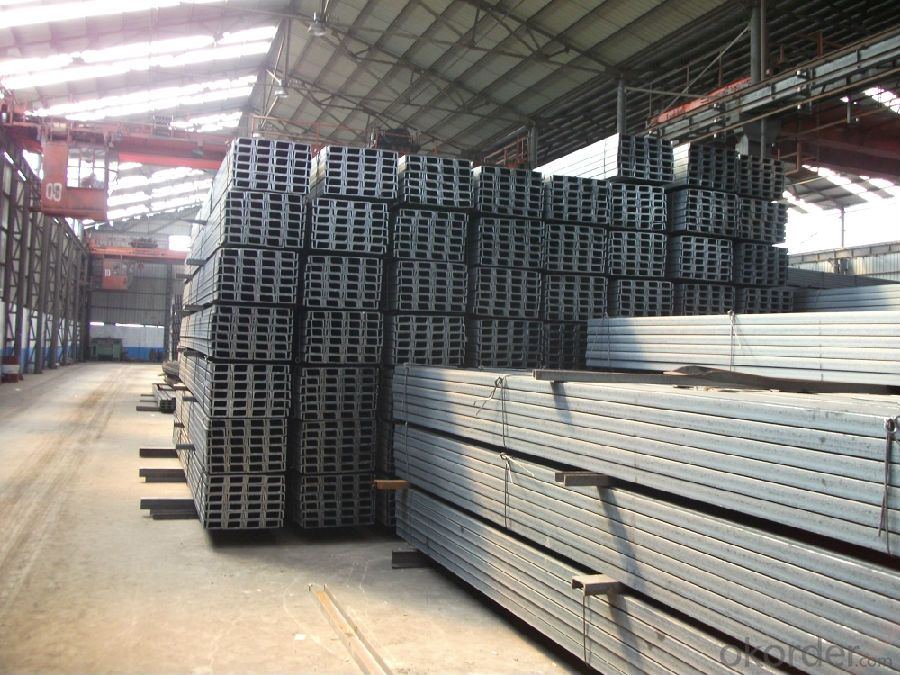
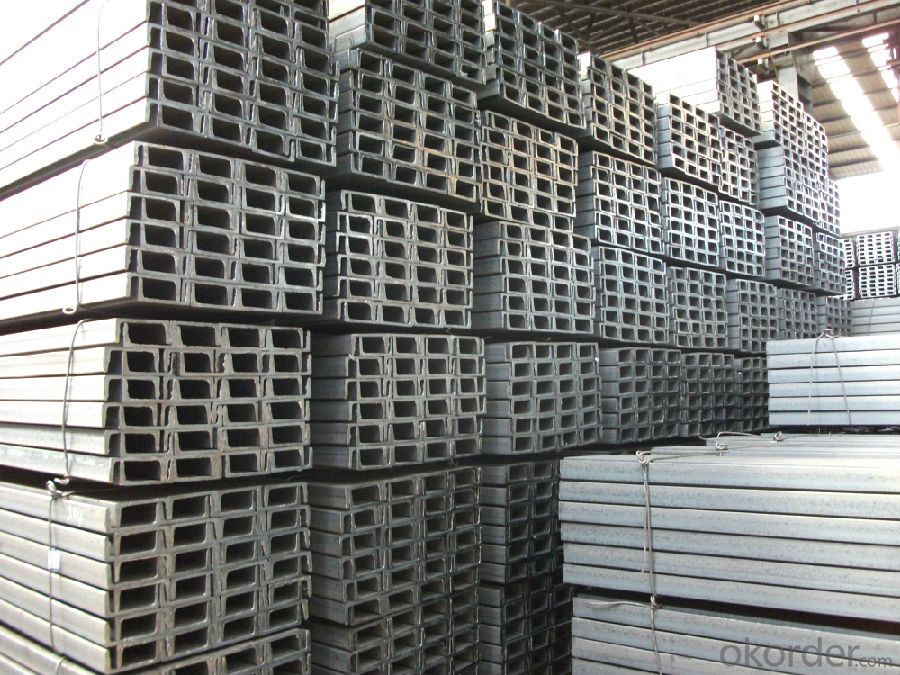
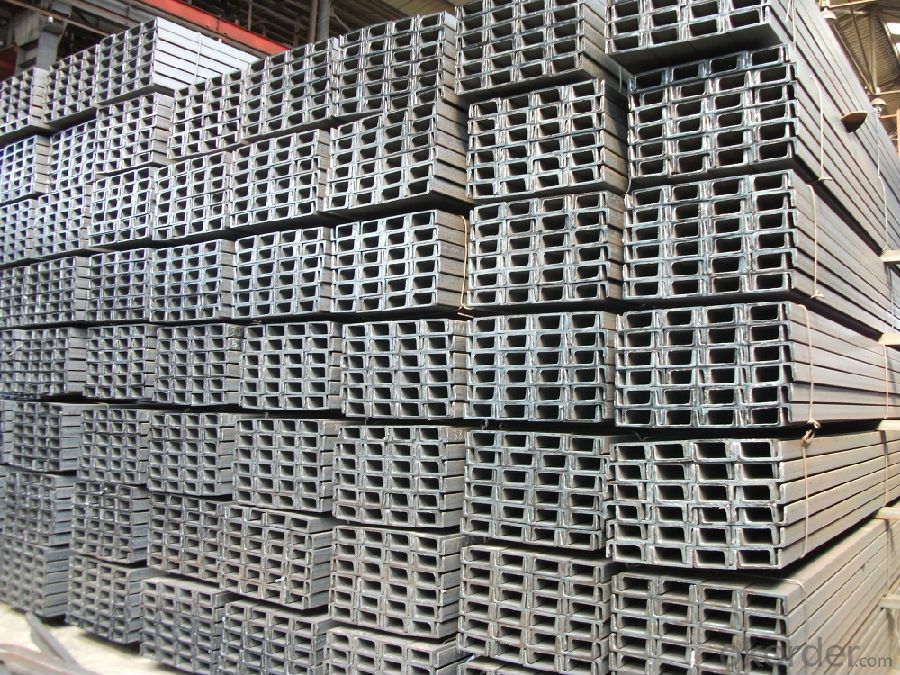
- Q: What are the factors to consider when selecting the appropriate steel grade for a channel?
- When selecting the appropriate steel grade for a channel, there are several factors that need to be considered. 1. Structural requirements: The first factor to consider is the specific structural requirements of the channel. This includes the load-bearing capacity, stiffness, and durability needed for the intended application. Different steel grades have different strengths and properties, so it is important to choose a grade that meets the structural requirements of the channel. 2. Corrosion resistance: Depending on the environment in which the channel will be used, it is important to consider the level of corrosion resistance required. Steel grades with higher levels of corrosion resistance, such as stainless steel, may be necessary in corrosive environments such as coastal areas or chemical plants. 3. Weldability: If the channel will be welded, it is important to consider the weldability of the steel grade. Some steel grades have better weldability than others, and this can impact the ease and quality of the welding process. It is important to choose a steel grade that can be easily welded to ensure the integrity of the channel. 4. Cost: The cost of the steel grade is another factor to consider. Different steel grades have different costs associated with them, so it is important to consider the budget constraints of the project. However, it is important to balance cost with the other factors mentioned above to ensure the appropriate steel grade is selected. 5. Availability: Lastly, it is important to consider the availability of the steel grade. Some steel grades may be more readily available than others, which can impact the timeline and logistics of the project. It is important to choose a steel grade that is easily accessible to ensure timely completion of the project. Overall, when selecting the appropriate steel grade for a channel, it is important to consider the structural requirements, corrosion resistance, weldability, cost, and availability. By carefully evaluating these factors, one can make an informed decision and select the most suitable steel grade for their specific needs.
- Q: What are the factors that affect the strength of steel channels?
- The strength of steel channels can be impacted by several factors. These factors encompass the steel type and quality, channel dimensions and shape, fabrication method, and environmental conditions. To begin with, the strength of channels can be significantly affected by the type and quality of the steel utilized. Different steel grades possess distinct mechanical properties like yield strength and tensile strength, which ultimately determine the overall strength of the channels. Superior quality steel with stronger properties will result in more robust channels. Additionally, the dimensions and shape of the channel play a pivotal role in its strength. A larger cross-sectional area and thicker wall can provide increased strength to the channel. Moreover, the channel's shape, whether it is C-shaped or U-shaped, can influence its strength as different shapes distribute loads in different ways. The fabrication method is another factor that impacts the strength of steel channels. The quality of welding or other joining techniques employed can affect the strength and integrity of the channels. Employing proper fabrication techniques, such as precise welding and appropriate heat treatment, can enhance the strength of the channels. Furthermore, environmental conditions can exert influence on the strength of steel channels. Factors like temperature, humidity, and exposure to corrosive substances can affect the structural integrity of the channels over time. For instance, high temperatures can cause the steel to weaken and become more susceptible to deformation. In conclusion, the strength of steel channels is influenced by various factors, including the type and quality of the steel, channel dimensions and shape, fabrication method, and environmental conditions. Understanding and considering these factors are crucial to ensure the desired strength and performance of steel channels in diverse applications.
- Q: How do steel channels perform in seismic zones?
- Steel channels are commonly used in construction in seismic zones due to their excellent performance under seismic loads. The shape of steel channels, with their wide flanges and narrow depths, provides high strength and stiffness, making them resistant to lateral forces and vibrations caused by earthquakes. Steel channels have the ability to dissipate and absorb seismic energy due to their ductility and high yield strength. This means that they can undergo large deformations without failure, allowing them to withstand the strong ground shaking experienced during earthquakes. In addition, steel channels can be designed and reinforced to enhance their seismic performance. For example, additional stiffeners or braces can be added to increase their resistance to bending and torsion. These reinforcement techniques help to distribute the seismic forces more evenly throughout the structure, minimizing the risk of localized damage. Furthermore, steel channels offer the advantage of being prefabricated, which ensures high quality and accuracy in their manufacturing. This allows for efficient and precise installation, reducing construction time and costs. Overall, steel channels have proven to be a reliable and effective choice for seismic zones. Their excellent strength, ductility, and ability to dissipate seismic energy make them a preferred option for engineers and architects when designing structures in areas prone to earthquakes.
- Q: A solar roof concrete foundation steel embedded parts, steel embedded parts are welded on the welding channel, two channel to head to head up, ask whether the welding part of a steel plate welding lining need? Or what other requirements? What norms do these requirements come from? Thank you
- Steel mosaic, can be spliced according to the below methods: adopt web side welding stiffened plate (installed in the groove of the inner channel of the stiffened plate, flange plate groove) by sealing welding, welding seam groove cutting and slag inclusions shall be clean; check inspection after welding. The web stiffener is greater than or equal to the thickness of the web. The dimension of the reinforcing plate is: the length of the steel plate is equal to the height of the section steel, and the width is equal to the height of the section steel, minus 70mm.
- Q: What type of channel steel and I-beam should be used to build an attic floor? Thank you!
- 1.16 channel steel is feasible plan, but channel used to do horizontal keel, you can open a little distance, 1 meters, 2 to 1 meters, 6 can be, and then spacing 400 with L50 or L60 angle steel connection can be. Do you have wood or steel plates to see what you're going to do upstairs?. 20 I-beam is really not necessary.2., if you use I-beam, you can directly slotted in the wall, and then inserted into the wall after the fixed, you can also use expansion bolts fixed channel, after the wall and then overlap I-beam, full welding.3. with 20 I-beam, the distance can be controlled to 1.6 meters. With channel, then the spacing to control 1.2 meters more appropriate, the middle should use angle steel to do cross brace.
- Q: Can steel channels be used for equipment enclosures?
- Yes, steel channels can be used for equipment enclosures. Steel channels provide structural stability and durability, making them suitable for housing and protecting equipment. They can be easily customized and adapted to accommodate various sizes and types of equipment. Additionally, steel channels offer excellent shielding against external elements and provide enhanced security for the enclosed equipment.
- Q: How do steel channels compare to other building materials?
- Steel channels have several advantages over other building materials. Firstly, steel channels have a high strength-to-weight ratio, making them an ideal choice for structural support applications. They can withstand heavy loads and provide excellent stability and durability. Additionally, steel channels are highly resistant to fire, corrosion, and pests, which makes them a reliable and long-lasting option for construction projects. They do not rot, warp, or require frequent maintenance, making them a cost-effective choice in the long run. Moreover, steel channels offer versatility in design and construction. They can be easily customized and fabricated to meet specific project requirements. Steel channels also provide flexibility during the construction process, as they can be easily modified or reinforced if needed. Furthermore, steel channels are environmentally friendly. They can be recycled and reused without losing their properties, making them a sustainable choice for construction projects. Steel production also requires less energy compared to other building materials, reducing the carbon footprint. Lastly, steel channels offer cost-effectiveness. While the initial cost may be higher than some other materials, the long-term benefits outweigh the investment. They require minimal maintenance and have a longer lifespan, resulting in lower maintenance and replacement costs over time. Overall, steel channels are a superior choice compared to other building materials due to their strength, durability, resistance to fire and corrosion, versatility, sustainability, and cost-effectiveness.
- Q: The following steel is not section bar, is it? A. thread steel, B. steel pipe, C. track, D. channel steel
- In accordance with the different smelting quality of steel, steel is divided into ordinary steel and high quality steel. According to the current catalogue of metal products, ordinary steel can be divided into large section steel, medium section steel and small section steel. The section steel can be divided into I-beam, channel steel, angle steel, round steel and so on according to its sectional shape. Large steel: large steel, I-beam, channel steel, angle steel and flat steel are hot rolled, round bar, Fang Gang, six angle iron in addition to hot rolling, there are forging, cold drawn and so on.
- Q: How are steel channels protected against corrosion in marine environments?
- Various methods are utilized to protect steel channels from corrosion in marine environments. Among these methods, the application of protective coatings is widely employed. These coatings create a barrier that shields the steel from the corrosive elements present in marine environments. Epoxy coatings are commonly used for marine applications due to their exceptional resistance against saltwater and other corrosive agents. Another approach to safeguard steel channels in marine environments is through cathodic protection. This technique involves the utilization of sacrificial anodes, which are made from a more reactive metal like zinc or aluminum. These anodes are affixed to the steel channels and intentionally corrode in place of the steel. By doing so, they divert the corrosive elements away from the steel channels, effectively preventing their corrosion. Furthermore, it is crucial to conduct regular maintenance and inspections on the steel channels in order to prevent corrosion in marine environments. This entails routine cleaning of the channels to eliminate any marine growth or debris that could trap moisture and accelerate corrosion. Additionally, inspections should be carried out to identify any signs of corrosion or damage, allowing for prompt repairs or replacement of affected areas. To summarize, the protection of steel channels from corrosion in marine environments involves the application of protective coatings, cathodic protection, and regular maintenance and inspections. These measures play a vital role in prolonging the lifespan of the steel channels and ensuring their structural integrity in the challenging conditions of marine environments.
- Q: What are the common maintenance requirements for steel channels?
- Steel channels, like any other steel structures, require regular maintenance to ensure their longevity and optimal performance. Some of the common maintenance requirements for steel channels include: 1. Regular cleaning: Steel channels should be cleaned regularly to remove dirt, dust, and other debris. This can be done using a mild detergent and water solution, followed by rinsing with clean water and drying with a soft cloth. Avoid using abrasive cleaners or scrub brushes that can damage the surface. 2. Inspection for corrosion: Corrosion is a common issue with steel channels, especially in areas with high humidity or exposure to moisture. Regularly inspect the channels for signs of rust or corrosion and address any issues promptly. Use a wire brush or abrasive pad to remove any surface rust, and apply a suitable rust inhibitor or paint to prevent further corrosion. 3. Lubrication of moving parts: If the steel channels have moving parts, such as sliding doors or windows, it is important to lubricate them regularly to ensure smooth operation. Use a lubricating oil or grease specifically designed for steel to prevent friction and wear. 4. Check for structural integrity: Periodically inspect the steel channels for any signs of damage or structural issues. Look for cracks, dents, or any deformities that may compromise the strength and stability of the channels. If any issues are found, consult a professional for repair or replacement. 5. Paint touch-ups: Over time, the paint on steel channels may chip, fade, or peel. Regularly inspect the paintwork and touch up any areas that require attention. This will not only enhance the aesthetic appeal but also provide an additional layer of protection against corrosion. 6. Proper drainage: Ensure that the steel channels have proper drainage systems in place to prevent the accumulation of water. Standing water can lead to corrosion and other structural issues. Clear any debris from drains and gutters to ensure proper water flow. By following these common maintenance requirements, steel channels can be kept in good condition, ensuring their durability and functionality for years to come.
Send your message to us
U Channel Hot Rolled Steel Made In China GB JIS EN DIN
- Loading Port:
- Tianjin
- Payment Terms:
- TT OR LC
- Min Order Qty:
- 50 m.t.
- Supply Capability:
- 40000 m.t./month
OKorder Service Pledge
OKorder Financial Service
Similar products
Hot products
Hot Searches
Related keywords
